What is Council of Europe?
Council of Europe, or so-called Linkup ransomware, is a new type of web browser locker infection that is designed by cyber criminals to make destruction on affected operating system and ultimately benefit from victims. According the resent security reports, the Council of Europe virus is commonly prompted via drive-by-download that often happens surreptitiously. To be specific, this type of infected may be lurked onto a targeted machine when users visit malicious websites or legitimate web pages that have been compromised. In addition, Council of Europe ransomware may be spread with the aid of Trojan horse or other destructive PC threats which has the capability to take advantage of system vulnerabilities to drop and install the components of Council of Europe virus. When executed, Council of Europe ransomware will immediately replicate its codes and registry files so that to make chaos in kernel system.
This may include Windows boot sector, which is responsible for the bootload of operating system. As a result, the infection could be activated automatically every time Windows boots up. By using its advanced hack techniques, Council of Europe scam will generally block user’s browsers from assessing, and fraudulently claim that the computer has been suspected and monitored by local law enforcement agency due to it being involved with prohibited Pornographic contents. To unlock user’s browser, the threat will requires victims to submit their personal information for it and then ask money for restriction to be removed. However, when users click on the malign link provided Council of Europe virus, it may be able to invade users’ hard drive and steal user’ confidential data. Without any doubts, computer users should try their best to get rid of Council of Europe ransomware infection as long as being informed of its existence to avoid unexpected damage or loss.
Screenshot of Council of Europe virus
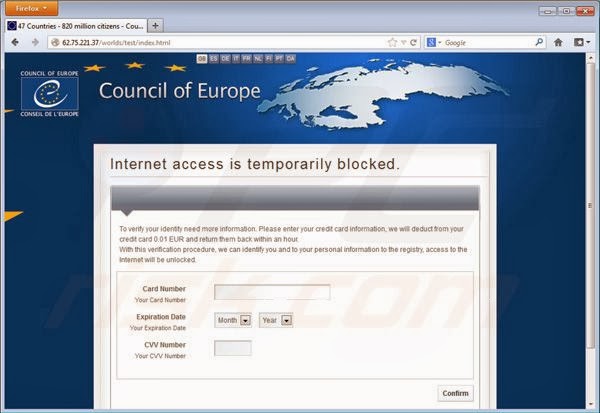
Common properties of Council of Europe scam
1. It downloads and installs rogue software without your permission.
2. It disables executable applications and antivirus on your computer.
3. It gives fake warnings to mislead you to pay for it.
4. It blocks opening legitimate websites but its purchase page.
5. It causes your computer slowing down and even crashing from time to time.
How to Remove Council of Europe Ransomware
Major computer users may find that computer has found weird symptoms on contaminated system, but installed Antivirus or Anti-spyware has no report about any viruses. In this Internet era, viruses are developing, so do their hiding techniques. It takes time for Antivirus to update its definition or signature. Council of Europe is the tricky and stubborn virus to handle by new computer users. If there is no proper Council of Europe removal tool, then this risky virus should be removed with effective method manual approach. To manually get rid of Council of Europe virus from Windows xp, vista, 7 and win 8 from your PC, here are the useful removal steps.
1. Safe Mode with Command Prompt
For Windows XP, 7 & Vista
Boot your computer into safe mode with networking by restarting your computer and keeping pressing F8 key and then using arrow key to get into that mode.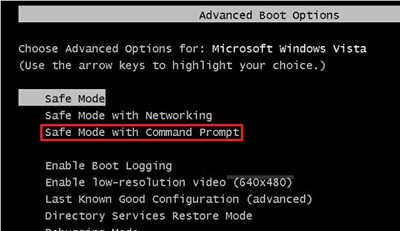
For Windows 8
- Start your computer, hold down the Shift key and hit the F8 key (Shift+F8) repeatedly. The Recovery Mode Window would pop up, choose the option of See advanced repair options.
- The Choose an option screen will appear, choose the Troubleshoot option to continue.
- You will get there options in the Troubleshoot Window, click on or select the Advanced Options.
- Now the Window Startup Settings option will come up. Click on Restart Button to continue.
- Here, you will get the Advanced Boot Options that involved with Safe Mode with Command Prompt.
- Highlight the Safe Mode with Command Prompt option or press number key 6 to enable Safe Mode with Command Prompt.
2. When the CMD (cmd.exe) Window pops up, type explorer and press Enter.
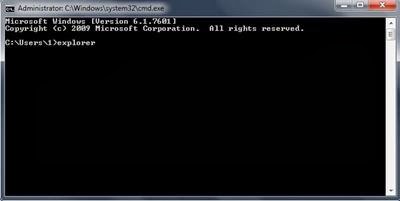
3. Stop the process of Council of Europe virus.
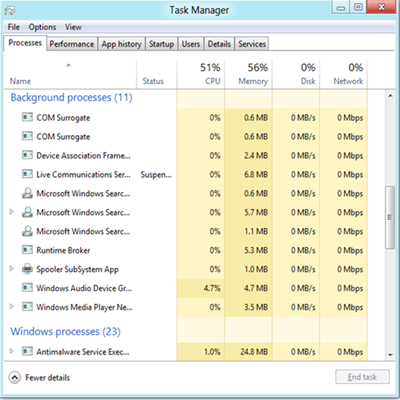
4. Remove the files related to Council of Europe virus.
%Temp%\[RANDOM CHARACTERS].exe
C:\Documents and Settings\<Current User>
C:\Users\<Current User>\AppData\
5. Remove the registry files related to Council of Europe virus.
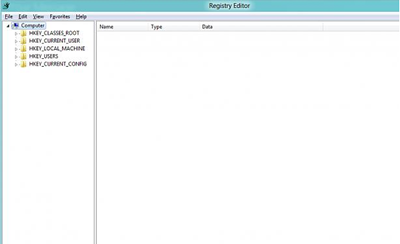
HKEY_LOCAL_MACHINE\SOFTWARE\Microsoft\Windows NT\CurrentVersion\Winlogon\
HKEY_CURRENT_USER\Software\Microsoft\Windows\CurrentVersion\Run\random
Conclusion: To get rid of Council of Europe ransomware virus, manual removal is known the most effective approach to completely remove all its related processes, dll.files and registry files. However, since some files might be hidden or changed, so you should realize that manual removal of Council of Europe virus is a cumbersome procedure and does not ensure complete deletion of the malware. Besides, manual interference of this kind may cause damage to the system. So we strongly recommend you get help from VilmaTech online agents who will save your time and guarantee the needed result.


ReplyDeleteAre you willing to know who your spouse really is, if your spouse is cheating just contact cybergoldenhacker he is good at hacking into cell phones,changing school grades and many more this great hacker has also worked for me and i got results of spouse whats-app messages,call logs, text messages, viber,kik, Facebook, emails. deleted text messages and many more this hacker is very fast cheap and affordable he has never disappointed me for once contact him if you have any form of hacking problem am sure he will help you THANK YOU.
contact: cybergoldenhacker at gmail dot com